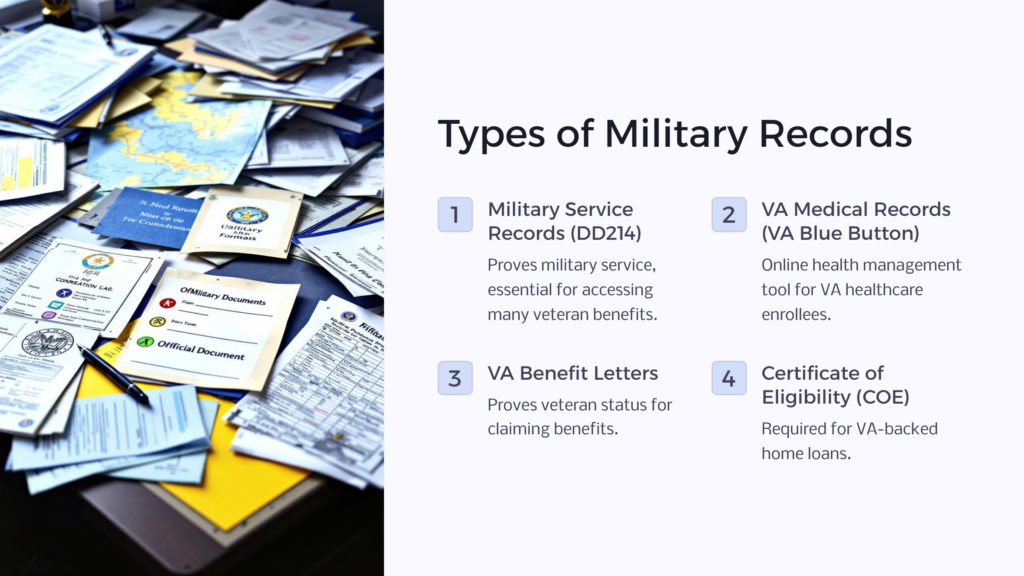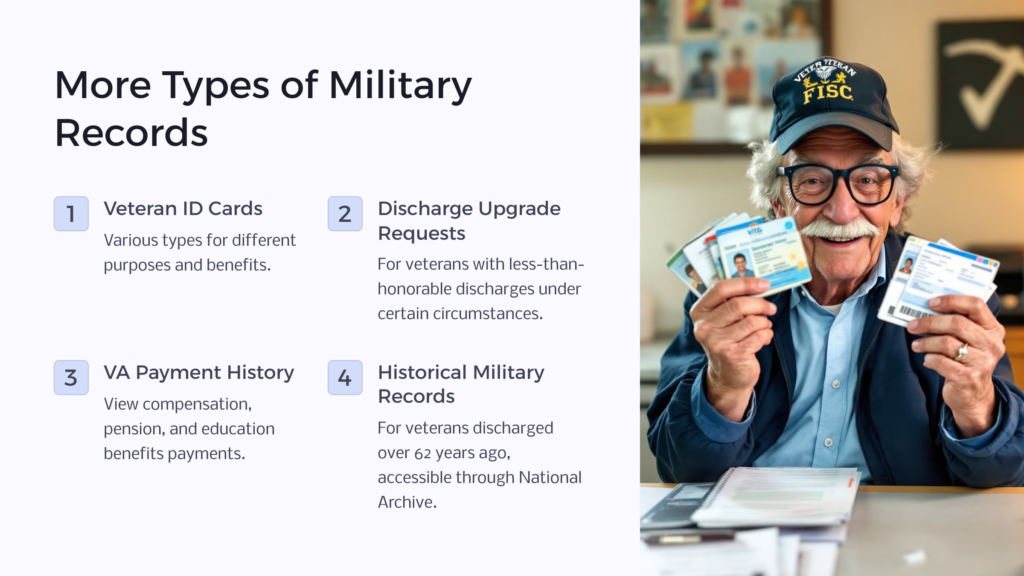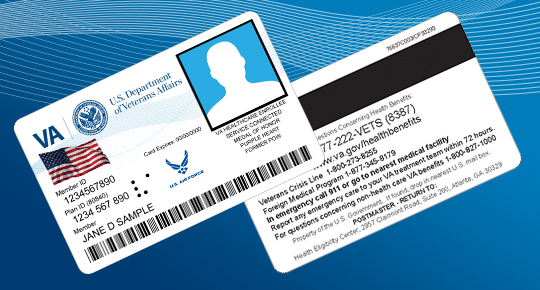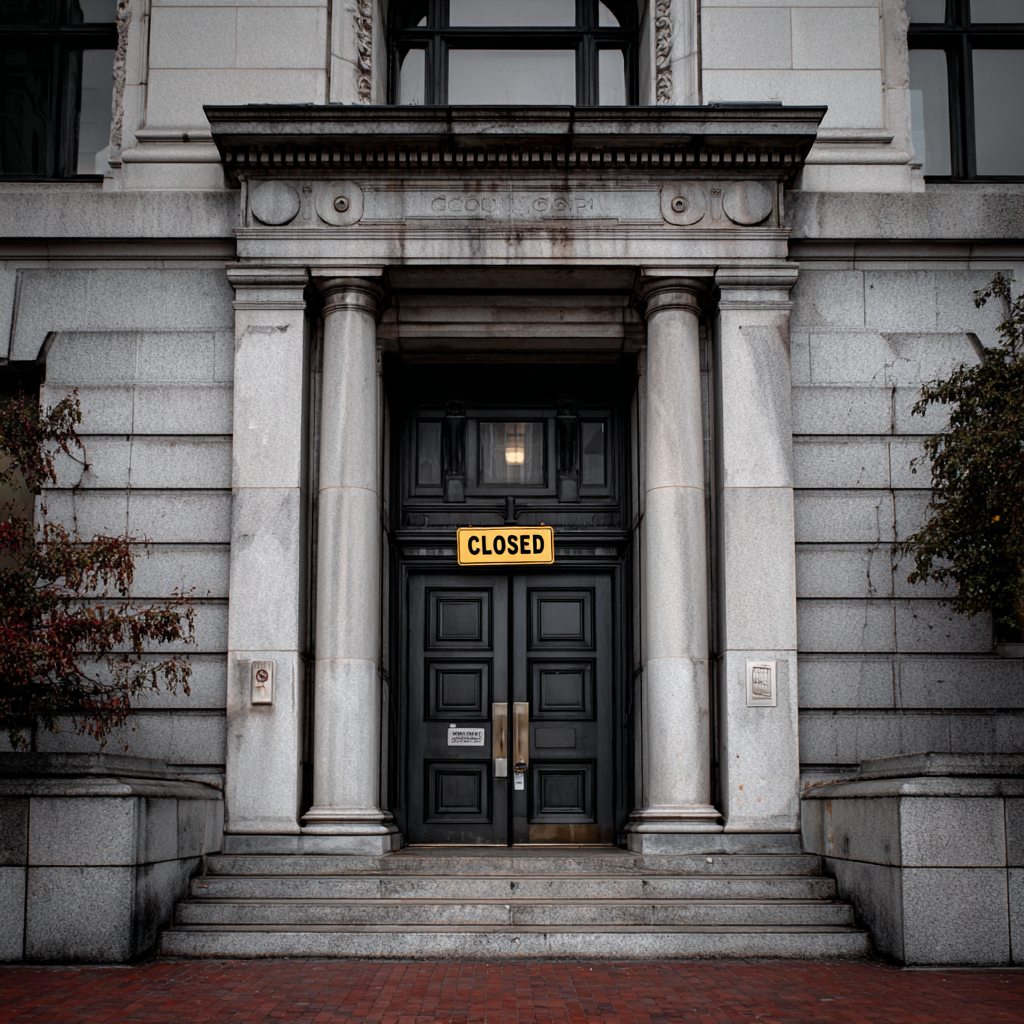Veterans will often need access to their military records to access benefits and services only available to those who’ve served in the country’s armed forces. Every veteran has an Official Military Personnel File (OMPF) and by law must have access to any records within this file.
Most personnel records are now available online, but you’ll still need to know the basics of how to log in, what documentation you’ll need, and how these records can be used to claim your benefits.
8 Types of Military Records and Documents
- Military Service Records (DD214)
- VA Medical Records (VA Blue Button)
- VA Benefit Letters
- Certificate of Eligibility
- Veteran ID Cards
- Discharge Upgrade Requests
- VA Payment History
- Historical Military Records
From health care to home loans to retail and business discounts, our country’s veterans have access to numerous assistance programs and the Department of Veterans Affairs (VA) maintains a comprehensive online database to provide these. To make a military records request you’ll usually only need basic personal information about yourself and your time of service, although certain military personnel records will require more documentation.
8 Types of Military Records and Documents:

Military Service Records (DD214)
Veterans who need to request a military service record will need a DS Logon account and to create an account through milConnect and make a formal request. The most common type of record needed is Form DD214 (sometimes referred to as separation documents). This report proves your military service and allows you to access many of the benefits offered to veterans including health services, mortgage programs, retirement funds, or membership to veteran organizations.
Once signed into your account, you’ll choose Defense Personnel Records Information (DPRIS) from the drop-down menu under Correspondence/ Documentation. From there find the Personnel File tab and click on Request My Personnel File to fill out a form and choose the documents you need in the Document Index section.
You can request as many as you need then click Create and Send Request. After this step, you should receive an email confirming your request was made and then a subsequent one when your forms are ready to be downloaded.
You can also request this form by mailing or faxing in a request to the National Personnel Records Center (NPRC) at 1 Archives Drive, St. Louis, Missouri 63138. You’ll need to include a completed copy of Standard Form SF 180, or visit the NPRC in person.
If you’re a family member or next of kin requesting documents for a deceased veteran you must request this document via mail, fax, in person, or by contacting your county veteran agency for assistance.
In the event you’re arranging funeral services for a family member, you can make an emergency request for records or a death certificate. These records aren’t available to the general public and only qualifying family members will have this access. However, records are made public after a veteran has been discharged for more than 62 years and then anyone can request an archival record through the National Archives.
Other forms available here are a DD215 (Correction To DD Form 214), orders and endorsements, performance reports, awards and decorations (commendatory items), qualifications, licenses, and certificates, or security clearance.
VA Medical Records (VA Blue Button)
The VA Blue Button is an online health management tool run through My HealtheVet. Through it you can access your health records and print, send, download, share, or save documents for personal reference or to share with your healthcare team. To be eligible for Blue Button you must be enrolled in VA health care and be a registered patient at a VA health facility. However, once you’re in the system you can download both your health records and your military medical records, access medical images and reports, monitor vital signs and diet and exercise goals, download health summaries, and share past medical records with new providers.
You can access these records through a premium DS account, a premium My HealtheVet account, or an ID.me account. From your Blue Button account click on Health Records to access your medical treatment records. Most record sharing within the VA system is done through the Veterans Health Information Exchange (VHIE), which allows for the electronic transfer of a veteran’s records to community care providers and the Department of Defense.
VA healthcare members are automatically enrolled in the VHIE, but you can opt-out at any time either through your My HealtheVet account or by filling out and submitting form VA 10-10164 to your local Release of Information Office (ROI).
VA Benefit Letters
To receive most veterans benefits, you’ll need to prove your status as a former service member by requesting a VA benefit letter. Each veteran will have a specific list of choices they’re allowed to download once they login to their DS Logon, My HealtheVet, or ID.me account depending on their service record. The most commonly requested document is the VA Benefit Summary Letter (also called a VA Award Letter) that alerts you to the status of your VA disability claim, but you can also download documents like a Post-9/11 GI Bill statement of benefits.
Certificate of Eligibility
A Certificate of Eligibility (COE) enables veterans to receive a VA-backed home mortgage or a Native American Direct Loan. VA-backed loans are for those who have served in the armed forces and offer lower interest rates, lower down payments, and reduced terms for qualifying.
COEs can be requested by veterans, active duty service members, National Guard or Reserve members, or surviving spouses. If you’re a veteran you’ll need a copy of your DD214 papers, and those on active duty will need to submit basic personal information along with their dates of service and the name of the command providing the information.
If you served in the National Guard or Reserves and were never activated, you can still obtain a COE but you’ll need to provide personal information along with the number of creditable years served and the command providing the information. You can also provide NGB Form 22 or NGB Form 23.
Once you have this documentation, you can apply for your COE either online, by mail, or your lender can request a copy through the Web LGY system. It’s worth noting that simply obtaining your COE does not guarantee you’ll qualify for a VA-backed loan. You will still need to meet the criteria laid out by your lender.

Veteran ID Cards

There are four main types of veteran ID cards you may need. Most veterans will only need one, but it’s helpful to know about each type and know what they’re used for.
Department of Defense (DoD) Identification Card
A DoD ID card gives you access to services on military bases as well as military discounts available at many non-governmental retail locations. Typically, if you have this card you won’t need any other type of veteran identification. You can obtain a DoD ID if you’re retired from the military, on active duty, or are in the National Guard, Reserves, Selected Reserves, or Inactive Ready Reserve.
All cardholders must have a sponsor or be a sponsor themselves. To apply, fill out DD Form 1172-2 then submit it to a Real-Time Automated Personnel Identification System (RAPIDS) office.
Veteran Health Identification Card (VHIC)
Any veteran enrolled in the VA Health program will automatically get a VHIC that’s used to check in to appointments and receive discounts at stores, restaurants, or other businesses.

Veteran ID Card (VIC) VICs allow you to get retail or business discounts and prove your status as a veteran. You can qualify for one if you’ve served in active duty, the Reserves, or the National Guard and received an honorable or general military discharge. You can apply online through your DS Logon, My HealtheVet, or ID.me account. You’ll have to provide basic personal information, discharge documentation like a DD214, a copy of your existing ID, and a color photograph of yourself from the shoulders up (like a passport photo).
Veteran Designation on a State-Issued Driver’s License or ID
All states offer a veteran designation on a standard ID card or driver’s license. Each state will have its own requirements for obtaining this, but most will need to see a discharge paper like a DD214.
Discharge Upgrade Requests
If you’re a veteran who’s received a less-than-honorable discharge, you can make a discharge upgrade request if you meet certain criteria. Note that you still may be able to qualify for some VA services without an honorable discharge.
Most discharge certificates will show your status as Honorable, General (Under Honorable Conditions), Other Than Honorable, Bad Conduct, or Dishonorable. But, if you can show that you received a lower designation due to circumstances beyond your control, you may be able to get an upgrade. If you fall into one of these categories you can apply:
- You had a traumatic brain injury
- You suffered from mental health conditions like PTSD
- You received a lower designation due to your sexual orientation
- You were the victim of sexual trauma during your military service (sexual harassment or abuse)
You can apply for this upgrade confidentially through the VA’s website.
VA Payment History
You can view your payment history through your DS Logon, My HealtheVet, or ID.me account. Veterans will be able to see their disability compensation, pension benefits, and education benefits. A surviving spouse or family member can also view their survivors pension benefits, Survivors’ and Dependents’ Educational Assistance (DEA), and Dependency and Indemnity Compensation (DIC).
Veterans who have applied for disability compensation should have received the eligibility assessment along with their disability percentage. This will dictate how much compensation they’ll get, and any veteran who received at least a 10% disability rating will receive a payment within 15 days of notification. You can also change your mailing address or direct deposit information for payments through this service.
Historical Military Records
If you’re seeking a military record for a veteran who was discharged over 62 years ago, you can access them through the National Archive. This information is made accessible through the Freedom of Information Act (FOIA) and the Privacy Act and is intended to balance the need for veteran confidentiality and the public’s right to government information.
You can make an FOIA request online, by mail, or by faxing Standard Form 180 to 314-801-9195. You’ll need the veteran’s Social Security number, and for veterans who served up until 1974, you’ll also need their service number.

Requesting Your Military Records
A wide range of benefits is available to military veterans, including VA health clinics, VA-backed home loans, ID cards for discounts and services, services for homeless veterans, and memberships to veteran support groups. Many veterans may not know these services are available. While it’s usually a simple process to request documentation to obtain benefits, there’s a range of options and online platforms that can be confusing.
It’s important for veterans to understand how to access all their military records so they can take advantage of all the benefits and services they deserve.
 Benefits.com Advisors
Benefits.com Advisors
With expertise spanning local, state, and federal benefit programs, our team is dedicated to guiding individuals towards the perfect program tailored to their unique circumstances.
Rise to the top with Peak Benefits!
Join our Peak Benefits Newsletter for the latest news, resources, and offers on all things government benefits.





















